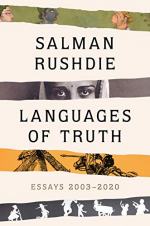|
This section contains 705 words (approx. 2 pages at 400 words per page) |

|
Languages of Truth: Essays 2003-2020 Summary & Study Guide Description
Languages of Truth: Essays 2003-2020 Summary & Study Guide includes comprehensive information and analysis to help you understand the book. This study guide contains the following sections:
This detailed literature summary also contains Topics for Discussion on Languages of Truth: Essays 2003-2020 by Salman Rushdie.
The following version of this book was used to create the guide: Rushdie, Salman. Languages of Truth. Penguin Random House LLC, 2021.
Salman Rushdie's Languages of Truth is a collection of essays spanning from 2003 to 2020. Throughout the collection, Rushdie employs a diverse range of essayistic styles, forms, and tonal registers in order to enact the protean nature of life and art. The following summary employs a simplified mode of explanation.
In Part One, "Wonder Tales," Rushdie considers story as a mode of survival, communication, and self-definition.
In "Proteus," Rushdie uses the god Proteus to suggest that like life, literature should embrace metamorphosis.
In "Heraclitus," Rushdie relies upon philosopher Heraclitus's Fragments to consider the relationship between character and destiny.
In Part Two, "Philip Roth," Rushdie recalls all of the ways that writer Philip Roth influenced and challenged him.
In "Kurt Vonnegut and Slaughterhouse-Five," Rushdie uses Kurt Vonnegut's Slaughterhouse-Five to consider the relationship between life and fiction.
In "Samuel Beckett's Novel," Rushdie reflects upon the ways in which Samuel Beckett's novels influenced his writing and thinking.
In "Cervantes and Shakespeare," 400 years after William Shakespeare's and Miguel de Cervantes Saavedra's deaths, Rushdie meditates upon the inexhaustibility of their work.
In "Gabo and I," Rushdie uses Gabriel García Márquez's work to form a conversation regarding magical realism.
In "Harold Pinter (1930 - 2008)," Rushdie describes his close relationship with playwright Harold Pinter.
In "Introduction to The Paris Review Interviews, Vol. IV," Rushdie considers what learning about writers' lives might teach the aspiring artist.
In "Autobiography and the Novel," Rushdie argues that a greater distinction should be made between life and fiction in contemporary literature.
In "Adaptation," Rushdie considers film adaptations of novels as works of translation.
In "Notes on Sloth: From Saligia to Oblomov," Rushdie interrogates the usefulness of morality in literature.
In "Hans Christian Andersen," Rushdie uses Hans Christian Andersen's stories to argue the importance of fantasy in literature.
In "King of the World by David Remnick," Rushdie discusses why David Remnick's biography about Mohammed Ali was successful.
In "Very Well Then I Contradict Myself," Rushdie emphasizes the importance of paradox in literature.
In Part Three, "Truth," Rushdie questions the artist's role in the contemporary era.
In "Courage," Rushdie asserts that artists must use their work to create change.
In "Texts for PEN," Rushdie presents five addresses he made at various PEN events, each of which explore art as a form of communication and connection.
In "Christopher Hitchens (1949 - 2011)," Rushdie reflects on Christopher Hitchens' life, work, and friendship on the day of his death.
In "The liberty Instinct," Rushdie considers America's particular regard for religious freedom.
In "Osama Bin Laden," Rushdie examines the ways in which administrations might distort the truth.
In "Ai Weiwei and Others," Rushdie presents various Chinese artists' encounters with adversity.
In "The Half-Woman God," Rushdie describes the hijra community in India.
In "Nova Southeastern University Commencement Address, 2006," Rushdie encourages graduates to embrace life and its experiential lessons.
In "Emory University Commencement Address, 2015," Rushdie implores graduates to question, seek, and make change.
In Part Four, "The Composite Artist: The Emperor Akbar and the Making of the Hamzanama," Rushdie uses the Hamzanama to consider the differences between composite and individual works of art.
In "Amrita Sher-Gil: Letters," Rushdie compares the artist Amrita Sher-Gil to one of his own fictional characters.
In "Bhupen Khakhar (1934 - 2003)," Rushdie commemorates the life of narrative painter and friend, Bhupen Khakhar.
In "Being Francesco Clemente: Self-Portraits," Rushdie notes the ways in which Francesco Clemente's self-portraits display the mutability of identity.
In "Taryn Simon: An American Index of the Hidden and Unfamiliar," Rushdie describes the distinctive and powerful nature of artist Taryn Simon's work.
In "Kara Walker at the Hammer Museum," Rushdie considers the ways in which Kara Walker uniquely exposes human truths in her work.
In "Sebastião Salgado," Rushdie explains why Sebastião Salgado is one of the best contemporary photographers.
In "The Unbeliever's Christmas," Rushdie describes his new Christmas traditions.
In "Carrie Fisher," Rushdie recalls his close friendship with actress Carrie Fisher.
In "Pandemic: A Personal Engagement with the Coronavirus," Rushdie reflects on the ways contracting COVID inspired his thoughts on culture, society, and truth.
In "The Proust Questionnaire: Vanity Fair," Rushdie ironically answers a series of personal questions.
Read more from the Study Guide
|
This section contains 705 words (approx. 2 pages at 400 words per page) |

|



